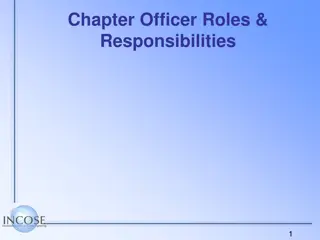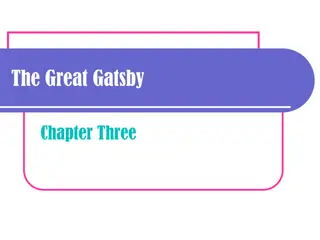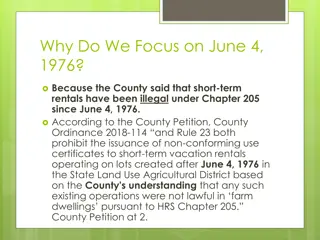
Understanding Matching Markets and Valuations
Explore the concept of matching markets, perfect matchings, valuations, and optimal assignments in bipartite graphs. Learn how prices can decentralize goods allocation and lead to socially optimal outcomes. Dive into constricted sets and the matching theorem for bipartite graphs.
Uploaded on | 0 Views
Download Presentation

Please find below an Image/Link to download the presentation.
The content on the website is provided AS IS for your information and personal use only. It may not be sold, licensed, or shared on other websites without obtaining consent from the author. If you encounter any issues during the download, it is possible that the publisher has removed the file from their server.
You are allowed to download the files provided on this website for personal or commercial use, subject to the condition that they are used lawfully. All files are the property of their respective owners.
The content on the website is provided AS IS for your information and personal use only. It may not be sold, licensed, or shared on other websites without obtaining consent from the author.
E N D
Presentation Transcript
Chapter 10 Matching Markets
Outline 10.1 Bipartite Graphs and Perfect Matchings 10.2 Valuations and Optimal Assignments 10.3 Prices and the Market-Clearing Property 10.4 Constructing a Set of Market-Clearing Prices 10.5 How Does this Relate to Single-Item Auctions? 10.6 Advanced Material: A Proof of the Matching Theorem
10.1 Bipartite Graphs and Perfect Matchings
Matching markets the way in which people may have different preferences for different kinds of goods the way in which prices can decentralize the allocation of goods to people The way in which such prices can in fact lead to allocations that are socially optimal
Bipartite Graphs An example of College dormitory
Perfect Matchings There are an equal number of nodes on each side of a bipartite graph, a perfect matching is an assignment of nodes on the left to nodes on the right, in such a way that each node is connected by an edge to the node it is assigned to no two nodes on the left are assigned to the same node on the right
Constricted Sets On the right-hand side of nodes: S On the left-hand side of nodes: neighbor of S We define the neighbor set of S, denoted N(S) Constricted Sets S contains strictly more nodes than N(S) does
Matching Theorem If a bipartite graph (with equal numbers of nodes on the left and right) has no perfect matching, then it must contain a constricted set.
10.2 Valuations and Optimal Assignments
Valuation allow each individual to express how much they d like each object, in numerical form
Valuation we can evaluate the quality of an assignment of objects to individuals 12 + 6 + 5 = 23
optimal assignment Maximizes the total happiness of everyone for what they get it does not necessarily give everyone their favorite item For example Room 1 is the best, but it can only go to one of them
Simple translation the problem of bipartite matching is implicit in the broader problem of finding an optimal assignment
10.3 Prices and the Market- Clearing Property
Prices and Payoffs Suppose that we have a collection of sellers, each with a house for sale, and an equal-sized collection of buyers The valuation that a buyer j has for the house held by seller i will be denoted vij sellers offer house for a price pi 0 Payoff = Vij - Pi
Prices and Payoffs if this quantity is maximized in a tie between several sellers, then the buyer can maximize her payoff by choosing any one of them if her payoff vij pi is negative for every choice of seller i, then the buyer would prefer not to buy any house
Prices and Payoffs 12 5 = 7 if she buys from a, 4 2 = 2 if she buys from b, 2 0 = 2 if she buys from c
Market-Clearing Prices the fact that each of the three buyers value the house of seller a the highest; it is the high price of 5 that dissuades buyers y and z from pursuing this house Market-Clearing Prices cause each house to get bought by a different buyer
Market-Clearing Prices an example of prices that are not market- clearing
Market-Clearing Prices this set of prices is market-clearing, even though a bit of coordination is required due to ties in the maximum payoffs.
Market-Clearing Prices A set of prices is market-clearing if the resulting preferred-seller graph has a perfect matching.
10.4 Constructing a Set of Market-Clearing Prices
Multiple auction At the start of each round, there is a current set of prices, with the smallest one equal to 0. We construct the preferred-seller graph and check whether there is a perfect matching If there is, we re done: the current prices are market-clearing If not, we find a constricted set of buyers S and their neighbors N(S)
Multiple auction If necessary, we reduce the prices the same amount is subtracted from each price so that the smallest price becomes zero We now begin the next round of the auction, using these new prices
Auction Must Come to an End the auction starts with only a bounded supply of this potential energy at the beginning, it must eventually run out potential of a buyer maximum payoff she can get from any seller potential of a seller the current price he is charging
Auction Must Come to an End all sellers begin with potential 0 each buyer having a potential equal to her maximum valuation for any house (P0 0) the potential changes when the prices change S has strictly more nodes than N(S) does The potential energy strictly decreases by at least one unit it can t drop below 0, so the auction must come to an end
10.5 How Does this Relate to Single-Item Auctions?
Single-Item Auctions we create n 1 fake additional sellers give buyer j a valuation of 0 for the item offered by each of these fake sellers
10.6 Advanced Material: A Proof of the Matching Theorem
The step Demonstration If a bipartite graph has no perfect matching, then it must contain a constricted set maximum matching a matching that includes as many nodes as possible Show that when enlarge fails, it produces a constricted set
Alternating and Augmenting Paths alternating path a simple path(did not repeat) that alternates between non-matching and matching edges
Alternating and Augmenting Paths In a bipartite graph with a matching, if there is an alternating path whose endpoints are unmatched nodes, then the matching can be enlarged
Alternating and Augmenting Paths Augmenting Path an alternating path with unmatched endpoints, it gives us a way to augment the matching
Searching for an Augmenting Path alternating BFS explore the rest of the graph layer by layer, adding new nodes to the next layer use non-matching edges from the left-hand side use matching edges from the right-hand side whether a layer containing an unmatched node from the left-hand side of the graph, we have found an augmenting path
Augmenting Paths and Constricted Sets the set of nodes in all even layers, at the end of a failed alternating BFS, forms a constricted set
Computing a Perfect Matching we will progress through a sequence of matchings look at current matching and find an unmatched node W
Computing a Perfect Matching use alternating BFS to search for an augmenting path beginning at W If find one, use this augmenting path to enlarge the matching If don t find one,stop with a constricted set that proves the graph has no perfect matching
Computing a Perfect Matching when the procedure stops with a constricted set, it does not mean that we have a maximum matching
Computing a Perfect Matching Start from w Start from y














